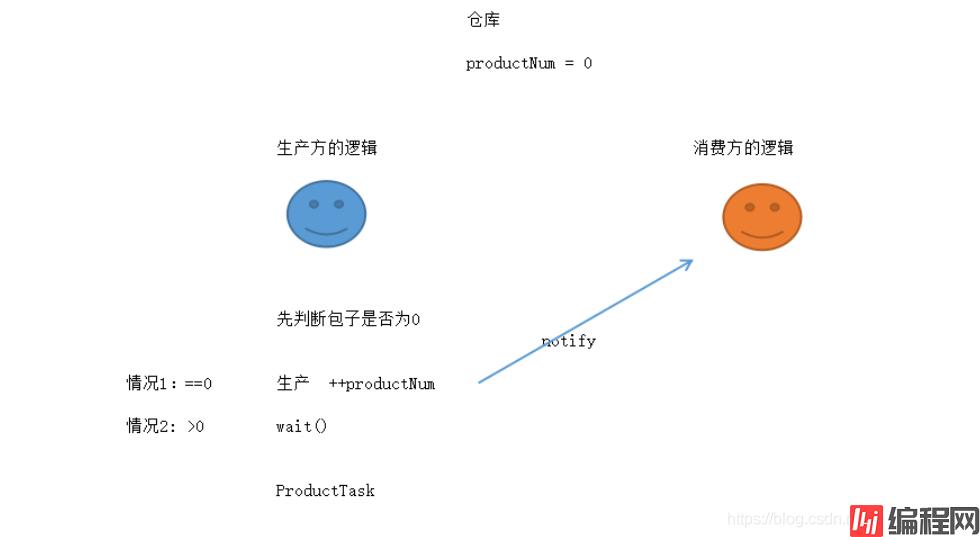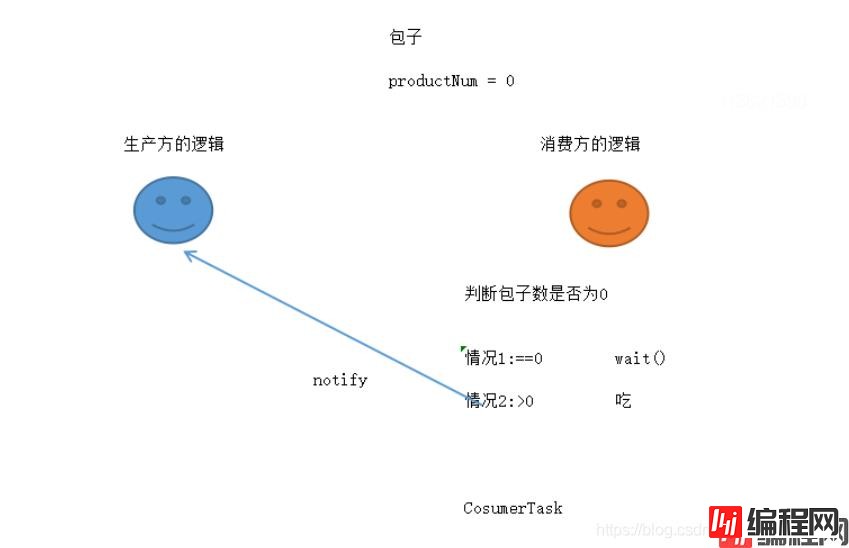Python 官方文档:入门教程 => 点击学习
目录案例图解生产方逻辑图消费方逻辑图代码实现多个线程可以相互竞争,也可以互相协作完成一件事情。 Object的相关方法 Obje
多个线程可以相互竞争,也可以互相协作完成一件事情。
Object的相关方法
| Object相关方法 | 描述 |
|---|---|
| void wait() | 让当前线程等待,如果没有被唤醒,就一直等待 |
| void wait(long timeout) | 让当前线程等待指定毫秒值,如果到了指定的毫秒值自动唤醒 |
| void notify() | 唤醒一个线程,唤醒的是当前对象锁下的一个线程 |
| void notifyAll() | 唤醒所有线程,唤醒的是当前对象锁下面的所有线程 |
这些方法一定要放在同步代码块中去使用,并且这些方法要通过锁对象去调用【***】
案例:
生产方每生产一个产品就需要等待(通知)消费方消费完产品后才能继续生产
消费方每消费一个产品就需要等待(通知)生产方去生产产品后才能继续消费。


【注意】
notify、wait写在同步代码块中,并且使用同一个对象(共有对象:仓库)进行操作。
this.cangku.wait() 和this.wait() 前一个使用的是仓库对象 ,后一个使用的是当前任务对象(使用后一个会造成死锁)
//仓库 - 唯一(锁对象,任何对象都可以,用共有对象做锁对象)
class CangKu { //当作 锁对象
//定义一个变量体现数量
public int productNum = 0;
}
//生产方和消费方共用一个仓库
//生产方
class ProductTask implements Runnable {
private CangKu cangKu; //共用一个仓库不能自己创建,由外部传入
public ProductTask(CangKu cangKu) { //通过构造函数初始化
this.cangKu = cangKu;
}
@Override
public void run() {
while (true) {
//通知notify与等待wait必须写在同步代码块中
synchronized (this.cangKu) {//判断是否有锁可用,有就进入
if (this.cangKu.productNum == 0) {
++this.cangKu.productNum; //生产数目+1
System.out.println("生产了一个产品,当前产品数目:" + this.cangKu.productNum);
//通知消费者,必须用同一个锁对象,不然会造成死锁
this.cangKu.notify();
} else {
//当前还有存货不用生产,等待通知
try {
System.out.println("生产方等待中...");
this.cangKu.wait();
} catch (InterruptedException e) {
e.printStackTrace();
}
}//end if
}//end synchronized 出房间释放锁
}
}
}
//消费方
class ConsumerTask implements Runnable {
private CangKu cangKu;
public ConsumerTask(CangKu cangKu) { //构造方法
this.cangKu = cangKu;
}
@Override
public void run() {
while (true) {
synchronized (this.cangKu) {
//判断,仓库是否为0
if (this.cangKu.productNum == 0) {
try {
System.out.println("消费方等待中...");
this.cangKu.wait();
} catch (InterruptedException e) {
e.printStackTrace();
}
} else {
//有货可以吃
-- this.cangKu.productNum ;
System.out.println("消费了一个产品,当前产品数目:" + this.cangKu.productNum);
//通知生产方生产产品
this.cangKu.notify();
}//end if
}//end synchronized
}
}
}
public class Wait_Notify_Demo {
public static void main(String[] args) {
//任务对象(生产方和消费方共用一个仓库)
CangKu cangKu = new CangKu();
ProductTask productTask = new ProductTask(cangKu);
ConsumerTask consumerTask = new ConsumerTask(cangKu);
//定义线程(用Executors线程池)
ExecutorService pool = Executors.newFixedThreadPool(2);
pool.submit(productTask); //生产
pool.submit(consumerTask); //消费
}
}
以上为个人经验,希望能给大家一个参考,也希望大家多多支持编程网。
--结束END--
本文标题: 基于线程的wait和notify使用,生产消费案例
本文链接: https://lsjlt.com/news/133112.html(转载时请注明来源链接)
有问题或投稿请发送至: 邮箱/279061341@qq.com QQ/279061341
2024-03-01
2024-03-01
2024-03-01
2024-02-29
2024-02-29
2024-02-29
2024-02-29
2024-02-29
2024-02-29
2024-02-29
回答
回答
回答
回答
回答
回答
回答
回答
回答
回答
0